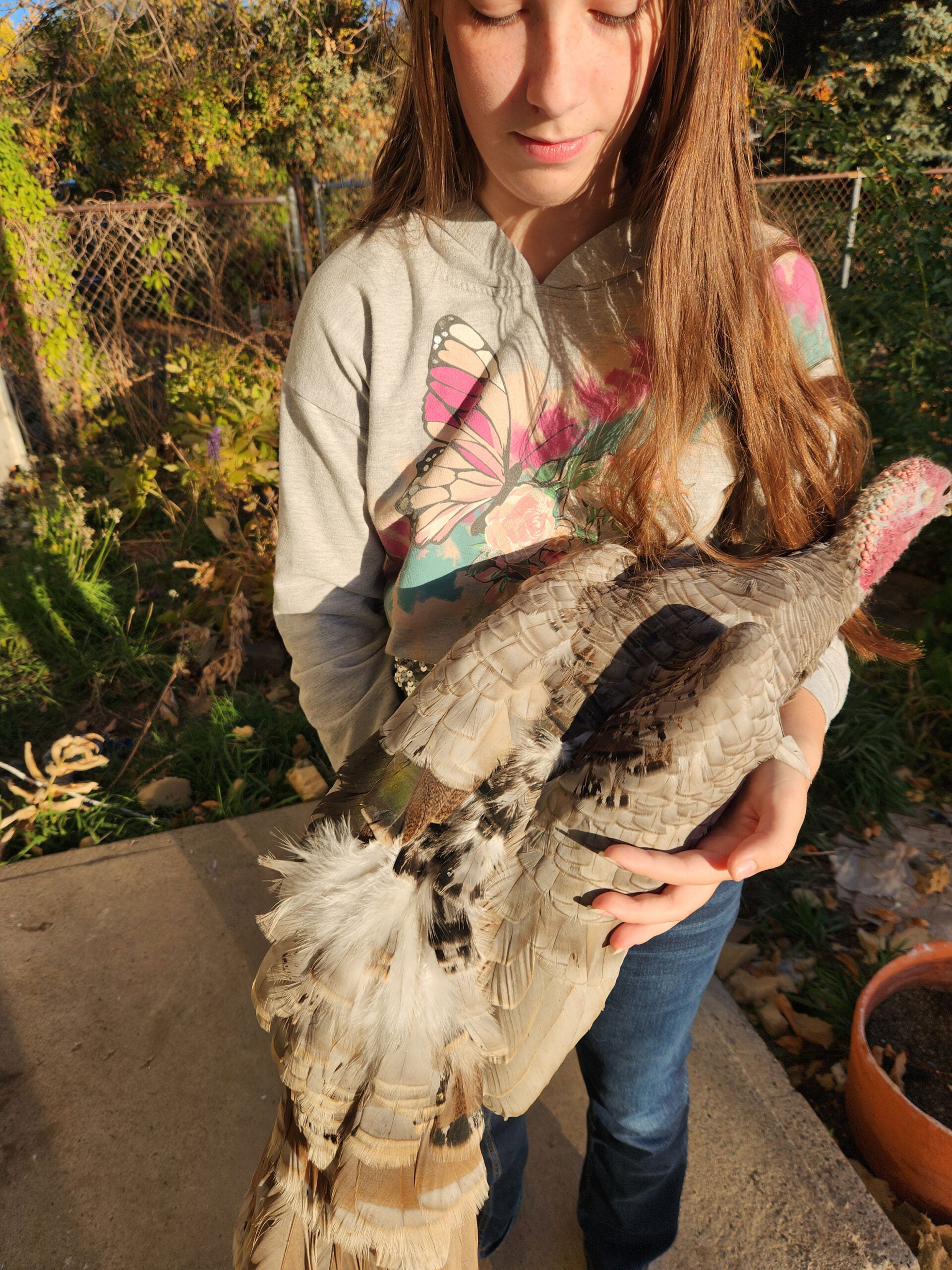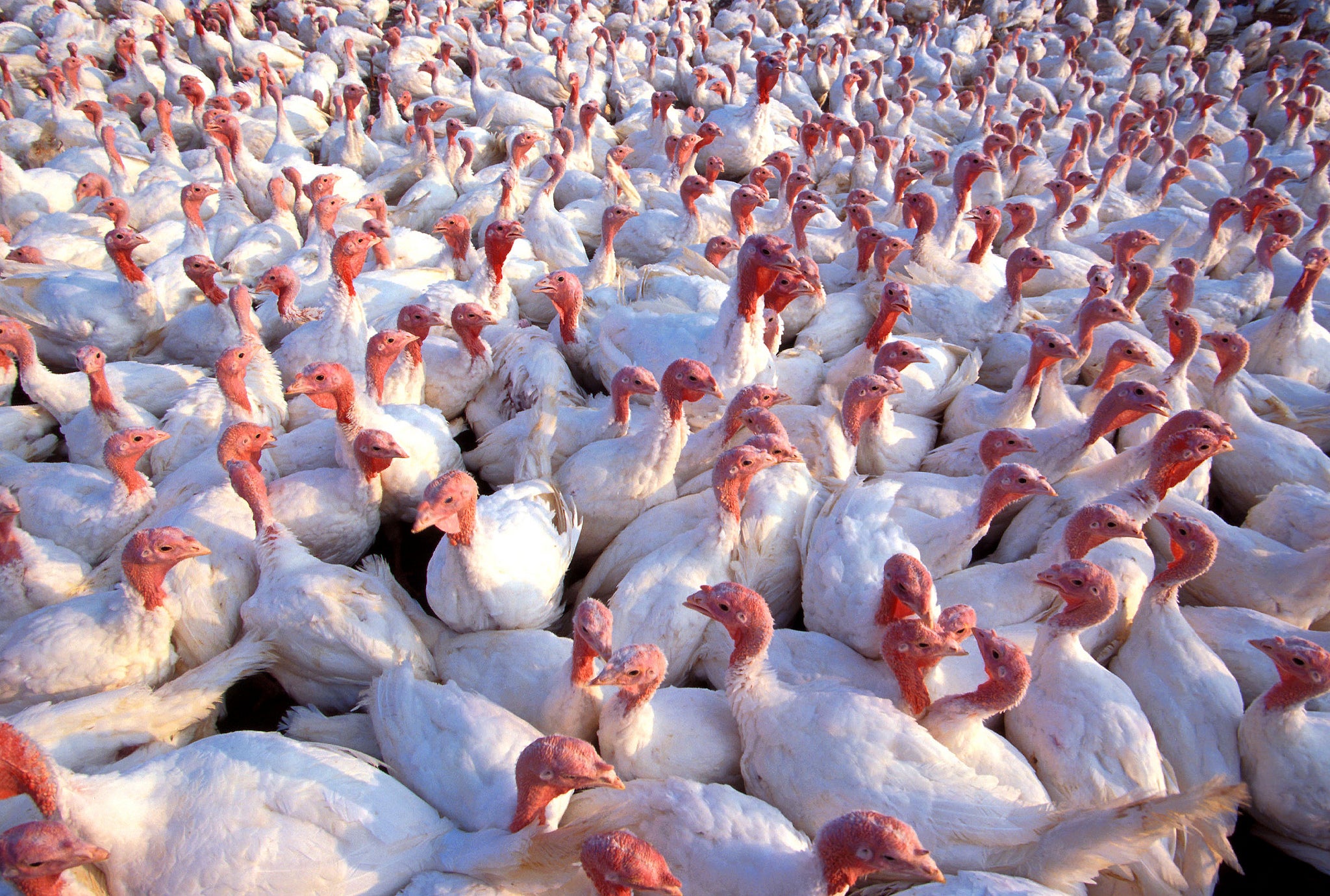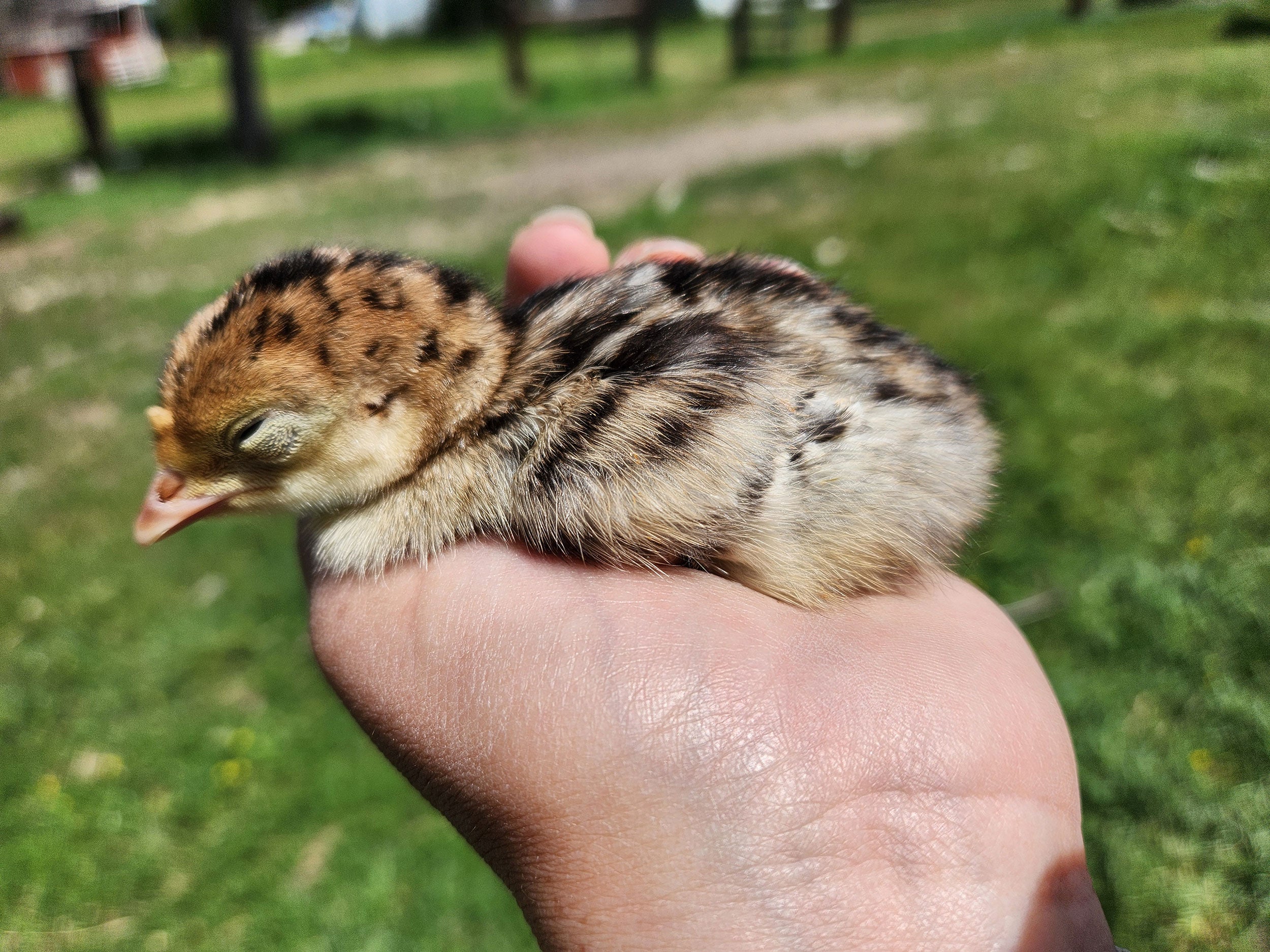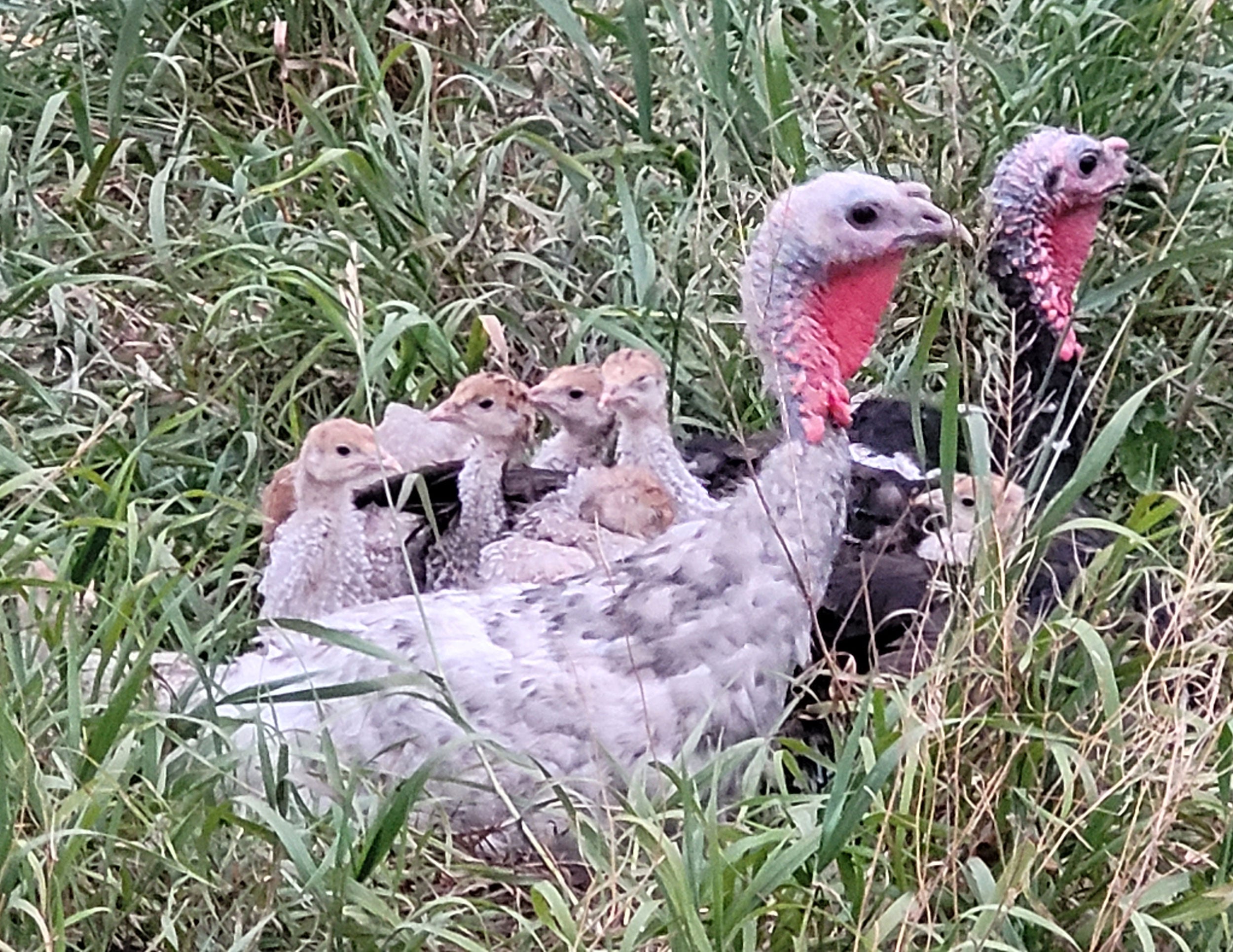For Sara Richardson of JLBar Farm in Montana, a once-in-a-lifetime bird emerged this year: Echidna, a rare mosaic chimera turkey.
“A chimera is a living organism that has absorbed a twin,” she explained. “This turkey hatched from a double-yolker and absorbed her twin early on during gestation.”
The poult struggled to emerge until Richardson’s daughter gently helped her into the world.
“The little poult was pipped and crying, but she was struggling to get out,” said Richardson. “My daughter rescued her, gently helping her hatch.”
Echidna’s body is a vibrant red slate, while her back and shoulders display striking bronze markings — traits that belonged to her absorbed twin.
The scientific rarity of mosaic chimeras makes Echidna an unusual and fascinating addition to the flock. These occurrences, while rare in the animal world, offer a glimpse into the complexities of genetic development. For Richardson, Echidna is more than a genetic curiosity — she’s a reminder of the surprises nature has in store and the unexpected beauty that can arise from the hard work of raising heritage turkeys.
“We’re keeping an eye on her feathering — it’s fascinating to see how she develops,” Richardson added.

This bird is just the latest step in the story of Richardson and JLBar Farm. When Richardson received her first pair of turkeys more than a decade ago, she never imagined the kind of lasting journey it would spark. A simple gift from a friend — a pair of broad-breasted turkeys that couldn’t stay in town — has evolved into a labor of love, a dedication to raising heritage turkeys that connects Richardson’s family to the land and their community.
Richardson’s initial plans for those first turkeys included butchering them for meat. Yet after her daughter’s grew a deep attachment to having turkeys around, it led their family to a new chapter on their farm.
“My daughter begged for turkeys until we bought a few poults the following spring,” said Richardson.
From there, her family pivoted to raising heritage breeds — specializing in Ridley Bronze turkeys developed in Saskatchewan in the 1940s and known for their natural hardiness, intelligence, and flavor.
Amid the hustle of commercial turkey farming across the nation, a quieter tradition thrives in Montana’s heritage turkey farms. Farmers such as Richardson and Hutterite communities across the state are redefining Thanksgiving tables with birds raised on personalized care, sustainability, and a deep respect for the land. Heritage turkey growers say that these birds, with rich flavor and natural hardiness, stand in contrast to their commercial counterparts — offering not just a meal but a story.
From preserving rare breeds to embracing ethical farming practices, these farmers are proving that the journey from pasture to plate is as rich and satisfying as the final dish itself.
The celebration of heritage
Heritage turkeys are quite different from broad-breasted varieties commonly found in grocery stores. While broad-breasted turkeys dominate the market due to their rapid growth and larger breast meat, Richardson said they can often be plagued with health problems like poor mobility and are susceptibility to predators.
According to Dr. Jacquie Jacob’s research on poultry for the University of Kentucky Extension, heritage turkeys require more space and specialized care, as they are more active and have different dietary needs compared to commercial breeds. He noted that heritage variety turkeys also must meet certain criteria.
For example, to be considered a heritage variety of turkey, a turkey must be able to mate naturally. Most of today’s commercial turkeys are too big to breed naturally and must be bred through artificial insemination. Additionally, a heritage turkey must have a long, productive lifespan outdoors and a slow growth rate.
This is one reason Richardson prefers raising heritage turkeys.
“They can naturally mate, are more resistant to predators, and won’t eat themselves to death,” Richardson explained. “They’re also smarter, which helps with survival, but that also means they can be harder to contain if something outside the fence catches their interest.”
Richardson hatches her birds in small batches, nurturing them through a series of brooders before releasing them to the main flock at two months old. Once fully integrated, the turkeys spend their days foraging across the family’s 35 acres, contributing to pest control in hay fields and gardens. By foraging for bugs, Richardson said the turkeys improve the quality of their meat and also help control bugs — a benefit that Richardson notes extends beyond her farm to the surrounding gardens and hayfields shared with her neighbors.
“I only feed them in the evenings during the summer,” she said. “This encourages them to forage for bugs all day, which keeps them healthy and improves the quality of their meat.”

On large-scale commercial farming operations, by comparison, birds are often confined and fed for maximum growth in minimum time. Researchers at Virginia Tech and the Livestock Conservancy in collaboration with eight breeders found that commercial broad-breasted turkeys had faster weight gain and better feed conversion than a heritage breed known as Bourbon Reds. The commercial variety turkeys achieved market weight around 18 weeks of age, while the Bourbon Reds required 26 weeks to reach the same weight. The Bourbon Red turkeys required 18 percent more feed per pound of weight gain. Yet, surprisingly, the carcass yield was similar for heritage and commercial varieties raised on pasture.
When compared to commercial turkeys, Richardson says her heritage birds deliver a culinary experience that her customers enjoy.
“The flavor and texture of the meat are deeper and firmer, like a fine steak,” Richardson said. “Store-bought turkeys seem bland and mushy in comparison.”
From small farms to Thanksgiving tables
Richardson’s heritage turkeys represent one end of a spectrum in the turkey farming industry. Small farms like hers play a crucial role in preserving traditional breeds, often acting as suppliers to larger farms or niche markets. She sells live poults and breeding-age turkeys locally, relying on platforms like Craigslist and her website to connect with customers.
While Richardson hatched 50 poults this year and sold about 30, last year she saw 80 poults sold out entirely. Her birds, harvested just days before Thanksgiving, range from 5-pound jennies to 20-pound jakes, providing fresh, high-quality options for holiday tables.
“This isn’t about maximizing profits,” Richardson emphasized. “It’s about raising healthy birds, feeding my family, and helping others enjoy the joy of high-quality, local food.”

Beyond farms like Richardson’s, Hutterite colonies in Montana contribute another layer to the turkey farming landscape. These a communal ethnoreligious societies, known for their commitment to quality and sustainability, produce sought-after birds in limited numbers. Much like Richardson’s turkeys, Hutterite birds are known for their exceptional taste and natural raising practices.
Joe Wipf, farmer at Mountain View Colony near Comanche, Montana, raises about 3,000 Thanksgiving turkeys on their farm. The turkeys start as small poults and can get up to 15 to 22 pounds with a few 30-pound turkeys for customers who want a larger bird. The turkeys eat about a ton of food a day and need fresh water.
“Everyone should have fresh water,” Wipf told The Associated Press. “Humans like to have fresh water, right?”
Fresh water and healthy diets are essential for raising high-quality turkeys. These birds are part of a tradition that balances hard work with care for the land. For example, there’s also a Hutterite practice that adds to the taste of their turkeys. By soaking the turkey in ice water to lower their body temperature right after processing, they say it helps preserve flavor. The birds are also sold only partially frozen. And for customers who like their turkeys freshly chilled, the colony allows for personal pick up.
Montana is home to more than 39 Hutterite colonies, run by German-speaking Anabaptists known for their hard work in producing eggs, pork, garden produce, and poultry. According to researchers from the University of Montana in a 2019 study with the Buruea Business of Economic Research, these colonies collectively produces 90 percent of Montana’s hogs, 98 percent of its eggs and 16 percent of poultry — including Thanksgiving turkeys.
Hutterite turkeys are a bridge between small-scale and commercial operations, aiming to maintain a balance between ethical, hands-on care and sustainable practices and the goal of larger production numbers.
Their birds sell out quickly, with families ordering weeks in advance to secure one for Thanksgiving.
Local appreciation
For those fortunate enough to secure one of these turkeys this Thanksgiving, it’s not just about the taste — it’s about the journey, the tradition, and the people behind it.
From Richardson’s farm to Montana’s Hutterite colonies, small-scale turkey farmers in this state are preserving more than just traditional breeds. They’re safeguarding a way of life that values sustainability, quality, and community. These farmers appreciate the support that people give to locals food production and the hands-on practices that help contribute to healthy food systems and preserve breeds that might otherwise be lost. Each bird, they say, is a testament to a sustainable future, where the focus shifts from convenience to connection.
As Richardson puts it, “When you know the farmer, you know the care that went into raising that bird.” And that connection — to the land, to the farmers, and to the heritage of these breeds — is a tradition worth celebrating this holiday season.

Suzanne Downing is an outdoor writer and photographer in Montana with an environmental science journalism background. Her work can be found in Outdoors Unlimited, Bugle Magazine, Missoulian, Byline Magazine, Communique, MTPR online, UM Native News, National Wildlife Federation campaigns and more.



